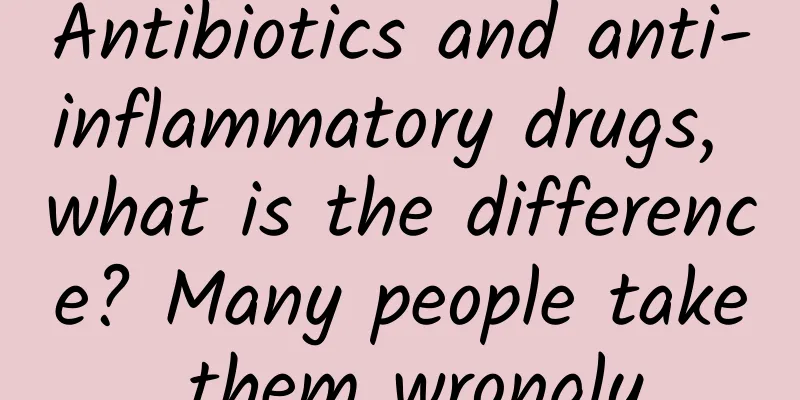Antibiotics and anti-inflammatory drugs, what is the difference? Many people take them wrongly

|
gossip "Cold, fever, toothache, sore throat, stomachache... maybe it's inflammation, take an anti-inflammatory medicine." In life, we often hear such statements. However, are we actually taking the so-called "anti-inflammatory medicine"? Are we taking the right medicine? Common household medicines in daily life, such as amoxicillin, cephalosporin, erythromycin and other drugs, are actually antibiotics. There are also many people who think that antibiotics are anti-inflammatory drugs, and it doesn't matter if they are mixed. What is the difference between the two? Today we will talk about antibiotics and anti-inflammatory drugs. After reading this article, you will no longer be confused about the difference. Copyrighted stock images, no reproduction is authorized analyze What is inflammation? Before we talk about drugs, let's first understand what inflammation is. Inflammation is what we usually call "inflammation". In fact, inflammation is an immune response to some kind of stimulation of the body, which manifests locally as redness, swelling, heat, pain and dysfunction, and may also be accompanied by systemic reactions such as fever and increased white blood cells. Many factors can cause inflammation. Infection (caused by bacteria, fungi, viruses, etc.) is the most common cause of inflammation, but inflammation may not be caused by infection. Non-infectious factors include physical factors, chemical factors, immune response factors, etc. Physical factors include trauma, scalds, ultraviolet burns, etc. Chemical factors include exogenous strong acids, strong alkalis, endogenous toxic substances, etc. Immune response factors include hypersensitivity reactions (such as allergic rhinitis, urticaria, etc.), and autoimmune diseases. Therefore, infection and inflammation sometimes have a causal relationship, but inflammation is not equal to infection. What are anti-inflammatory drugs? Now that we understand the causes of inflammation, let’s talk about medication. Copyrighted stock images, no reproduction is authorized In medicine, drugs that eliminate inflammation mainly include two categories: non-steroidal anti-inflammatory drugs and steroidal anti-inflammatory drugs. Nonsteroidal anti-inflammatory drugs are one of the most commonly used anti-inflammatory drugs in clinical practice. They have multiple effects such as anti-inflammatory, analgesic, and antipyretic; therefore, they can be used to treat arthritis, gout, pain, etc. Nonsteroidal anti-inflammatory drugs mainly include aspirin, ibuprofen, celecoxib, etc. This type of anti-inflammatory drug can reduce the synthesis of prostaglandins by inhibiting cyclooxygenase, and prostaglandins are endogenous chemicals that can cause inflammation, pain, and fever in the body. Since some nonsteroidal anti-inflammatory drugs are over-the-counter drugs, be especially careful not to overdose. Nonsteroidal anti-inflammatory drugs often have adverse reactions, including peptic ulcers, gastrointestinal bleeding, platelet dysfunction, renal damage, liver damage, etc. The occurrence of these adverse reactions is related to the dosage and duration of use. When using nonsteroidal anti-inflammatory drugs, when the dosage reaches a certain level, increasing the dosage will not enhance its effect, but the drug toxicity reaction will increase significantly. Steroidal anti-inflammatory drugs (glucocorticoids) have multiple effects such as anti-inflammatory, anti-allergic, anti-shock and antipyretic. Therefore, they are used to treat inflammatory diseases such as autoimmune diseases such as rheumatoid arthritis. They have no analgesic effect and mainly include prednisone, hydrocortisone, dexamethasone, etc. Glucocorticoids can inhibit inflammatory responses by inhibiting the synthesis of inflammatory mediators, inhibiting the migration of inflammatory cells, and enhancing the synthesis of anti-inflammatory cytokines. Since this type of drug is a hormonal drug, it has some side effects and may also mask some symptoms and affect the diagnosis of the disease. Therefore, it should not be used indiscriminately and must be used with caution as directed by a doctor. What are antibiotics? Antibiotics can only be considered for inflammation caused by infection. Antibiotics, formerly known as antimicrobials, are substances produced by microorganisms (including bacteria, fungi, and actinomycetes) that can kill or inhibit other microorganisms. Commonly used antibiotics in clinical practice are divided into natural antibiotics and artificial semi-synthetic antibiotics. Commonly used antibiotics include β-lactams, aminoglycosides, macrolides, lincomycins, peptides, antituberculosis drugs, antifungal drugs and other antibiotics. Copyrighted stock images, no reproduction is authorized In daily life, most people may have taken antibiotics such as amoxicillin and cephalosporin. Antibiotics can only be used for inflammation caused by bacteria and some other microorganisms (such as mycoplasma, chlamydia, etc.), and are completely ineffective against inflammation caused by viruses. Generally, pharyngitis and upper respiratory tract infections are mostly caused by viruses. In addition, antibiotics have no effect in preventing colds. How to avoid overuse of antibiotics? The misrepresentation of antibiotics as “anti-inflammatory drugs” is one of the important reasons for the overuse of antibiotics in my country. Overuse of antibiotics may promote the emergence of super-resistant bacteria, leading to difficult-to-treat infections in immunocompromised patients, which may ultimately endanger their lives. So, how can we avoid overuse of antibiotics? First, for individuals, if an inflammatory reaction occurs, they should seek medical attention in time to identify the cause. If it is confirmed to be a bacterial infection, antibiotics can be used. If the inflammation is caused by viral or non-infectious factors, rash use of antibiotics will not only be ineffective, but may even delay the disease and may cause adverse reactions. Second, it is important to identify bacterial infections. When taking antibiotics, you should not stop taking the medicine rashly after you feel better. You must complete the course of treatment as prescribed by the doctor. Using antibiotics for less than the course of treatment will induce the production and reproduction of drug-resistant bacteria. Some patients may think that after taking antibiotics for two days, their symptoms have improved, so they don't need to take the medicine and will get better slowly. In fact, it is easy for the disease to recur and drug resistance to occur. Third, high-level antibiotics or combined antibiotics should not be used rashly. Patients who do not understand the field of infection may think that expensive, high-level antibiotics are more effective; another type of patients want to get better sooner, so they take several antibiotics at the same time, which is actually very detrimental to recovery and can induce bacteria to develop resistance to high-level antibiotics or multiple antibiotics. Fourth, antibiotics should not be taken alternately. Some patients have a stockpile of multiple antibiotics at home, but they are running low. They think that they are all for treating bacterial infections, so they take one antibiotic today and another antibiotic tomorrow. This is actually more likely to induce the production of drug-resistant bacteria and increase adverse reactions in patients. Copyrighted stock images, no reproduction is authorized in conclusion The pharmacological mechanisms of antibiotics and anti-inflammatory drugs are very different. Bacterial infection will cause an inflammatory response in the body, and antibiotics are used to kill or inhibit the growth and reproduction of bacteria. When the pathogenic bacteria are eliminated, the inflammatory response caused by the body will naturally disappear gradually. Therefore, people will have the illusion that antibiotics are anti-inflammatory drugs. However, antibiotics do not target the inflammation itself, but the pathogenic bacteria that cause inflammation. They indirectly play an anti-inflammatory role and cannot be called anti-inflammatory drugs. Especially when the "inflammation" is not caused by bacterial infection (such as fungal or viral infection), the use of antibiotics cannot play an anti-inflammatory role, but will cause adverse reactions. Author: Wei Ming, Assistant Researcher, Department of Infection and Clinical Microbiology, Beijing Chaoyang Hospital, Capital Medical University Reviewer: Liu Lihua, Chief Physician, Department of Pharmacy, Changsha Third Hospital References: [1] Nankervis H, Thomas KS, Delamere FM, et al. Scoping systematic review of treatments for eczema. Southampton (UK): NIHR Journals Library; 2016 May. (Programme Grants for Applied Research, No. 4.7.) Chapter 6, Antimicrobials including antibiotics, antiseptics and antifungal agents. Available from: https://www.ncbi.nlm.nih.gov/books/NBK363143/ [2] Patel P, Wermuth HR, Calhoun C, et al. Antibiotics. [Updated 2023 May 26]. In: StatPearls [Internet]. Treasure Island (FL): StatPearls Publishing; 2023 Jan-. Available from: https://www.ncbi.nlm.nih.gov/books/NBK535443/ [3] InformedHealth.org [Internet]. Cologne, Germany: Institute for Quality and Efficiency in Health Care (IQWiG); 2006-. What is an inflammation? 2010 Nov 23 [Updated 2018 Feb 22]. Available from: https://www.ncbi.nlm.nih.gov/books/NBK279298/ [4] Ghlichloo I, Gerriets V. Nonsteroidal Anti-Inflammatory Drugs (NSAIDs) [Updated 2023 May 1]. In: StatPearls [Internet]. Treasure Island (FL): StatPearls Publishing; 2023 Jan-. Available from: https://www.ncbi.nlm.nih.gov/books/NBK547742/ [5] Vaughn VM, Hersh AL, Spivak ES. Antibiotic Overuse and Stewardship at Hospital Discharge: The Reducing Overuse of Antibiotics at Discharge Home Framework. Clin Infect Dis. 2022 May 3;74(9):1696-1702. doi: 10.1093/cid/ciab842 Planning丨Zhong Yanping Editor: Li Mengxin The article is produced by "Science Refutes Facts" (ID: Science_Facts). Please indicate the source when reprinting. The cover image and images within this article are from the copyright gallery. Reprinting and quoting them may lead to copyright disputes. |
<<: Are “artificially modified” pets cute or pathetic?
>>: How did Leonardo da Vinci use the Mona Lisa to "cheat" you?
Recommend
Photos of the reddish lunar soil are black and white? Space cameras are very different from everyday cameras!
On June 25, my country's Chang'e-6 return...
Why Mars is the first choice for deep space exploration
Human exploration of Mars began in the 1960s. The...
June Marketing Node Reminder [Dry Goods Collection]
June is coming, and there are still many hot spot...
Apple Pay's most practical function has been released. Can it be used to defeat WeChat and Alipay?
Even though my iPhone had automatically updated t...
35 Douyin operation tools to attract fans and monetize!
Tik Tok is so popular that Tencent has launched 1...
Can be driven all over the country, 10 times safer than human driving, all models of Jiyue will be equipped with Baidu ASD for the first time
Everything is AI, and intelligent driving technol...
How much does it cost to make a shoe and boots mini program in Yueyang?
How much is the quotation for shoe and boot manuf...
Go to bed early and get up early VS go to bed late and get up late, which one is healthier? Read it in one article →
appendix: Review | Li Nannan Director of Hunan Sc...
Just now, Beijing issued the highest level of rainstorm warning! How to protect yourself in extreme weather?
Just now, Beijing issued a red warning for heavy ...
Lenovo is once again making efforts in smart TV. What are the chances of the PC industry giant making a comeback against the trend?
After experiencing a series of events that have l...
Is breast cancer really a cancer that is already written into our genes?
Breast cancer, like all other cancers, is caused ...
Analysis of mobile phone camera sensors
We all know that the most important part of determ...
Analysis of channel operation: 3 major elements + 1 major core point
In the Internet environment, it is said that traf...
2020 Beginner’s Guide to Private Domain Traffic System!
What is private domain traffic ? This is a relati...
For the first time! Chinese scientists successfully constructed a human immune system development map
Recently, researchers from the Shenzhen Institute...









